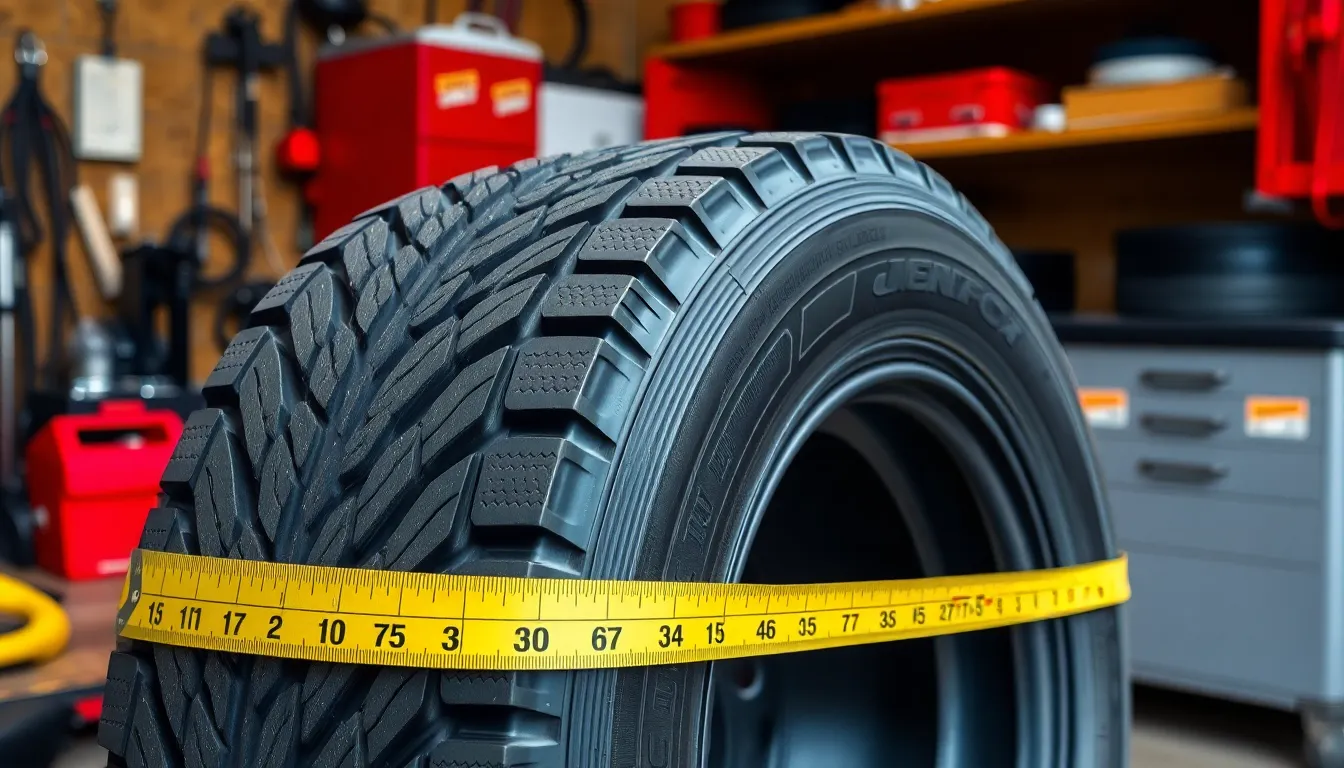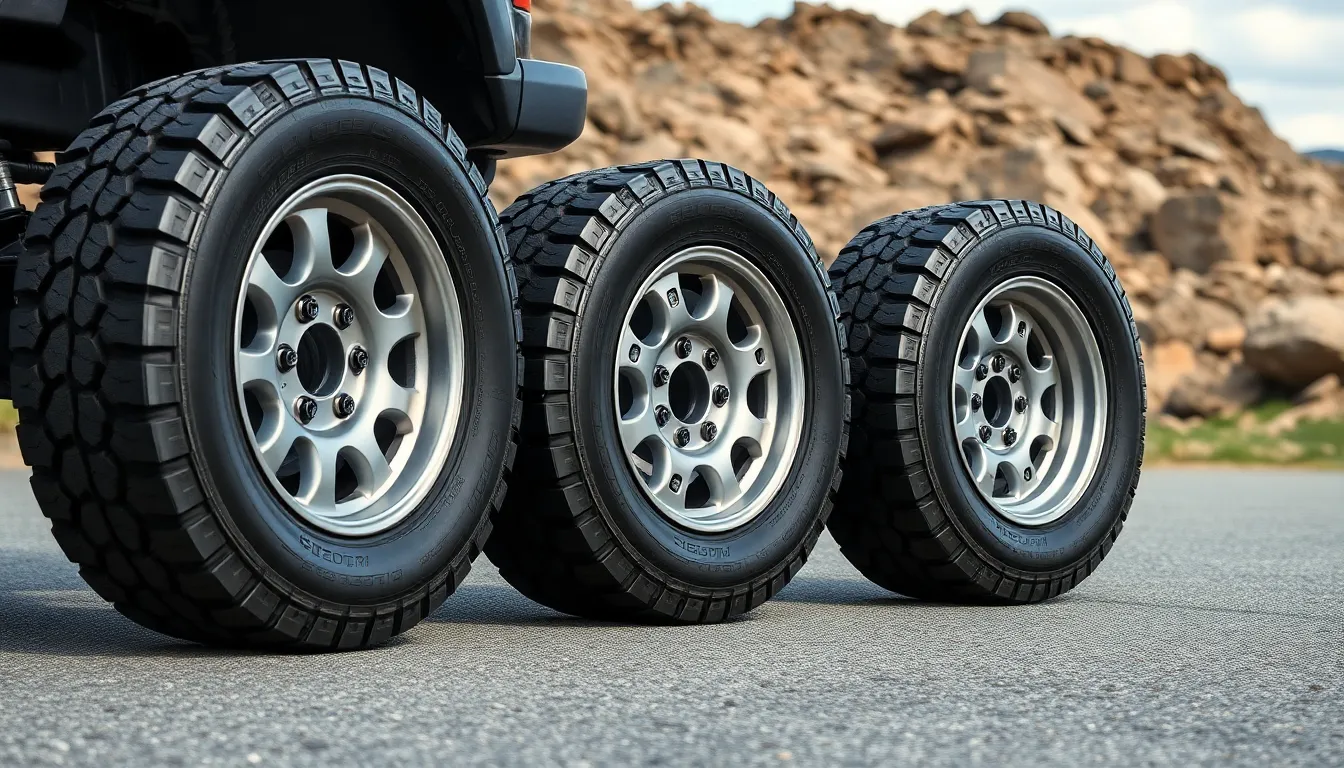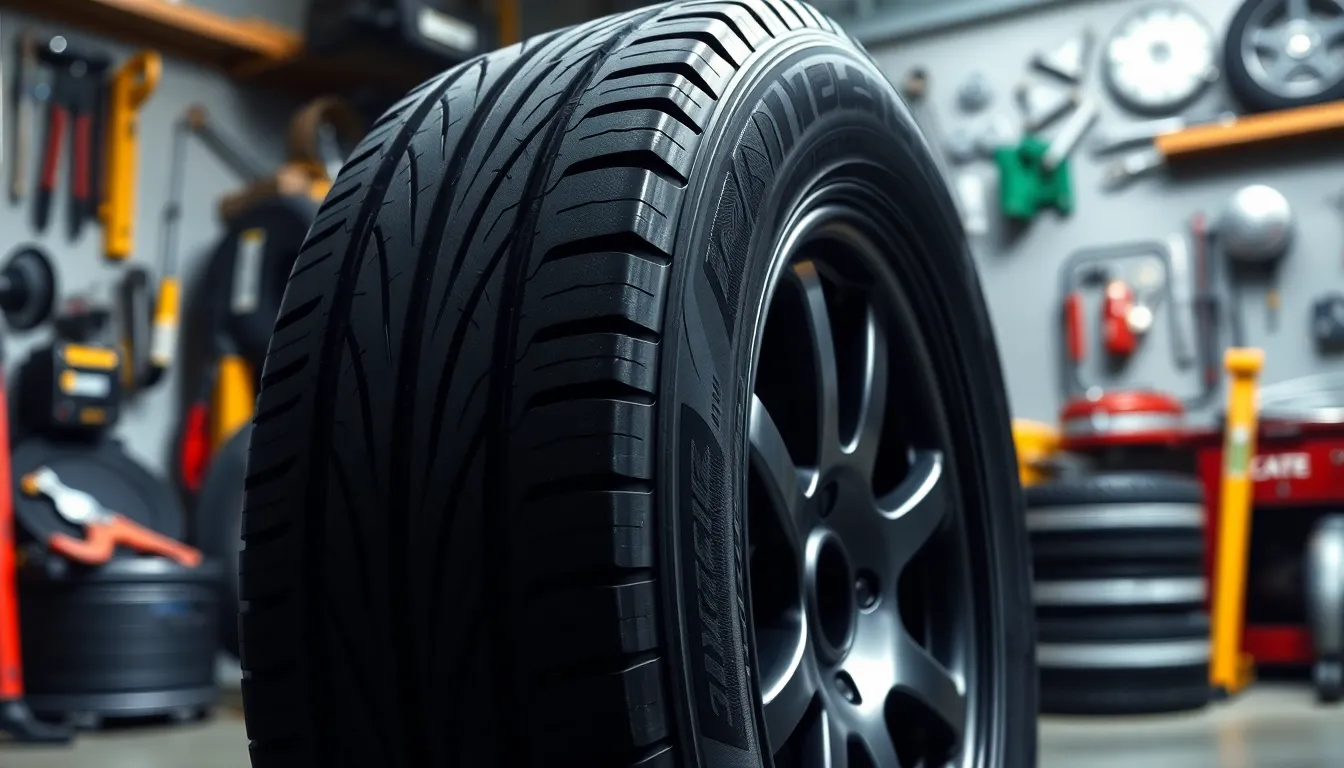When we’re shopping for new tires or planning modifications to our vehicle, understanding tire dimensions becomes crucial. The 265/70R17 tire size is incredibly popular among truck and SUV owners, but deciphering what those numbers actually mean for overall height can feel overwhelming.
We’ve all been there – staring at tire sidewalls wondering how these cryptic numbers translate to real-industry measurements. The height of your tire directly impacts everything from speedometer accuracy to ground clearance, making it essential knowledge for any vehicle owner.
The 265/70R17 tire measures approximately 31.6 inches in overall diameter. This measurement affects your vehicle’s performance, fuel economy, and appearance more than you might realize. Understanding how to calculate tire height from these specifications empowers us to make informed decisions about our vehicle modifications and replacements.
Understanding Tire Size Specifications
We decode tire specifications by analyzing the alphanumeric format that manufacturers use across the industry. This standardized system provides precise measurements that determine compatibility and performance characteristics.
Breaking Down the 265/70R17 Format
The 265/70R17 designation follows the P-metric tire sizing system established by the Tire and Rim Association. We read this format from left to right to understand each component’s exact function.
The first number represents the tire’s width measured in millimeters from sidewall to sidewall. The second number indicates the aspect ratio as a percentage of the width. The letter designates the tire’s construction type. The final number specifies the wheel diameter in inches.
Modern tire manufacturers stamp this information directly onto the sidewall to ensure accurate identification. We find additional markings including load index and speed rating adjacent to the primary size designation.
What Each Number Represents
265 indicates the tire width measures 265 millimeters across the tread surface when mounted on the recommended rim width. We convert this measurement to approximately 10.43 inches for easier visualization.
70 represents the sidewall height as 70% of the tire’s width measurement. We calculate this by multiplying 265mm by 0.70 to get 185.5mm or 7.3 inches for the sidewall height.
R designates radial construction where steel belts run perpendicular to the tire’s centerline. We encounter this construction type in over 99% of passenger vehicle tires manufactured today.
17 specifies the wheel diameter as 17 inches measured from bead to bead across the center. We use this measurement to ensure proper fitment with compatible wheel assemblies.
| Component | Measurement | Conversion |
|---|---|---|
| Width | 265mm | 10.43 inches |
| Sidewall Height | 185.5mm | 7.3 inches |
| Wheel Diameter | 17 inches | 431.8mm |
| Overall Diameter | 803.2mm | 31.6 inches |
Calculating the Height of a 265/70R17 Tire

Computing the exact height of a 265/70R17 tire requires understanding the mathematical relationship between its dimensional components. We determine this measurement through a systematic approach that uses the tire’s specifications to arrive at the final height of 31.6 inches.
Step-by-Step Height Calculation
Breaking down the tire size components gives us the foundation for accurate height calculation. The section width measures 265 millimeters while the aspect ratio represents 70% of that width.
Multiplying the section width by the aspect ratio provides the sidewall height: 265 mm × 0.70 = 185.5 mm. This sidewall measurement appears on both the top and bottom portions of the tire.
Doubling the sidewall height accounts for both upper and lower sections: 185.5 mm × 2 = 371 mm total sidewall contribution. Adding the rim diameter of 17 inches (431.8 mm) to the total sidewall measurement gives us the complete tire height.
| Calculation Component | Metric Value | Imperial Value |
|---|---|---|
| Section Width | 265 mm | 10.4 inches |
| Sidewall Height | 185.5 mm | 7.3 inches |
| Total Sidewall | 371 mm | 14.6 inches |
| Rim Diameter | 431.8 mm | 17 inches |
| Total Tire Height | 802.8 mm | 31.6 inches |
Converting Millimeters to Inches
Converting metric measurements to imperial units ensures compatibility with standard automotive applications in the United States. We divide millimeter values by 25.4 to obtain inch equivalents since one inch equals exactly 25.4 millimeters.
Applying this conversion to our sidewall height: 185.5 mm ÷ 25.4 = 7.3 inches per sidewall. The total sidewall contribution becomes 14.6 inches when we account for both upper and lower portions.
Final height calculation combines the 17-inch rim diameter with the 14.6-inch total sidewall measurement. This mathematical process consistently produces the 31.6-inch overall height for any 265/70R17 tire regardless of manufacturer or exact model variations.
Actual Height Measurements for 265/70R17 Tires

Real industry measurements for 265/70R17 tires consistently show an overall diameter of approximately 31.6 inches across most manufacturers. We’ve compiled the most accurate specifications based on industry data and manufacturer listings.
Standard Height Specifications
Industry standard specifications for 265/70R17 tires maintain consistent dimensions across manufacturers. The overall diameter measures 31.6 inches while the section width spans 10.4 to 10.7 inches depending on the exact brand and model.
Sidewall height reaches approximately 7.3 inches from the rim to the tread surface. Circumference totals 99.3 inches around the tire’s perimeter. These tires generate 657 to 658 revolutions per mile during normal operation.
Rim compatibility extends from 7.0 to 9.0 inch wide wheels with the standard 17 inch diameter. Width measurements can vary slightly between 10.4 and 10.7 inches based on tread design and manufacturing specifications.
| Specification | Measurement |
|---|---|
| Overall Diameter | ~31.6 inches |
| Section Width | 10.4-10.7 inches |
| Sidewall Height | ~7.3 inches |
| Circumference | ~99.3 inches |
| Revolutions per Mile | 657-658 |
| Rim Width Compatibility | 7.0-9.0 inches |
Variations Between Different Brands
Brand variations in 265/70R17 tire heights remain minimal across reputable manufacturers. The BFGoodrich All Terrain T/A KO2 measures exactly 31.6 inches in diameter, matching the industry standard for this tire size.
Most manufacturers advertise heights between 31.4 and 31.8 inches for their 265/70R17 models. Tread design differences and rubber compound formulations can create slight variations of a few tenths of an inch.
Reputable tire brands show no evidence of radical deviations from the 31.6 inch standard measurement. Inflation pressure, vehicle load, and tire wear can affect actual height measurements but these factors create only minimal changes to the nominal specifications.
Comparing 265/70R17 to Other Common Tire Sizes

Understanding how 265/70R17 tires measure against other popular sizes helps us make informed decisions about tire replacements and upgrades. These comparisons reveal critical differences that affect vehicle performance and compatibility.
Height Differences with Similar Sizes
We find important diameter variations when comparing 265/70R17 tires to similar sizes commonly used on trucks and SUVs. The 265/65R17 tire measures 30.56 inches in diameter, making it 1.04 inches smaller than our 265/70R17 reference tire. This difference creates a 3.3% speedometer variance that affects odometer readings and fuel economy calculations.
Moving to wider options, the 285/70R17 tire extends the overall diameter to 32.7 inches. This represents a 1.1-inch increase over the 265/70R17 size, resulting in a 3.4% speedometer difference. Such variations impact ground clearance and may require suspension modifications for proper fitment.
| Tire Size | Overall Diameter | Height Difference | Speedometer Impact |
|---|---|---|---|
| 265/65R17 | 30.56 inches | -1.04 inches | -3.3% |
| 265/70R17 | 31.6 inches | Reference | 0% |
| 285/70R17 | 32.7 inches | +1.1 inches | +3.4% |
Additional size comparisons show that 235/70R17 tires measure 30.0 inches in diameter, creating a 1.6-inch reduction from our baseline. Conversely, 275/70R17 tires reach 32.16 inches, adding 0.56 inches to the overall height.
Impact on Vehicle Performance
Larger tire diameters increase ground clearance and enhance off-road capabilities by providing better obstacle clearance. We observe improved approach and departure angles when upgrading from smaller diameter tires to 265/70R17 or larger sizes. This additional clearance proves beneficial for handling rocky terrain, deep snow, and uneven surfaces.
Speedometer accuracy becomes compromised when changing tire sizes without recalibration. Larger diameter tires cause speedometer readings to display slower speeds than actual vehicle velocity. Smaller diameter tires create the opposite effect, showing higher speeds on the gauge cluster than the vehicle’s true speed.
Fuel efficiency typically decreases with larger diameter tires due to increased rolling resistance and weight. We measure approximately 1-3% reduction in fuel economy when upgrading from 265/65R17 to 265/70R17 tires. The additional rotational mass requires more energy to accelerate and maintain highway speeds.
Handling characteristics change with tire size modifications, affecting steering response and cornering stability. Larger diameter tires often provide improved straight-line stability but may reduce acceleration performance due to increased leverage on the drivetrain. We recommend maintaining manufacturer specifications unless exact performance goals justify the trade-offs.
Wheel compatibility requirements restrict tire size options based on rim width specifications. The 265/70R17 tire fits wheels measuring 7.0 to 9.0 inches wide for passenger applications and 7.0 to 8.5 inches for light truck configurations. Proper fitment ensures optimal tire shape and performance characteristics.
Factors That Affect Tire Height

Several variables influence the actual height measurements of a 265/70R17 tire beyond its calculated specifications. Manufacturing tolerances and external conditions can create slight variations from the standard 31.6-inch diameter.
Load and Air Pressure Considerations
Air pressure maintains the tire’s structural integrity and affects its effective height measurements. Proper inflation keeps the 265/70R17 tire at its nominal 31.6-inch diameter while underinflation causes sidewall bulging that reduces overall diameter. Overinflation creates a small positive effect on height but manufacturers don’t recommend this practice due to safety and performance concerns.
Load capacity impacts tire compression under vehicle weight. Higher loads compress the tire slightly and reduce its effective height though this remains negligible unless the tire becomes severely under-inflated. Standard passenger loads create minimal height changes while maximum payload conditions may cause measurable compression in the sidewall area.
Vehicle weight distribution affects different tires unevenly across axles. Front tires often carry engine weight while rear tires support cargo loads which creates varying compression rates. Temperature changes also influence air pressure with every 10-degree Fahrenheit increase raising pressure by approximately 1-2 PSI and affecting overall tire dimensions.
Tread Wear and Age Effects
Tread wear reduces the overall tire diameter as rubber wears away from road contact. A new 265/70R17 tire loses material gradually through normal driving with most tires decreasing by less than one inch over their complete service life. Deep tread patterns on new tires add minimal height beyond standard calculations but this advantage diminishes with use.
Aging affects rubber composition though structural changes don’t significantly impact height measurements. Rubber hardens over time due to UV exposure and temperature cycling but these changes influence performance characteristics rather than dimensional properties. Sidewall degradation becomes visible through cracking or checking patterns yet the tire maintains its basic height profile unless structural failure occurs.
Driving conditions accelerate tread wear patterns differently across the tire surface. Highway driving creates even wear while aggressive cornering or frequent stop-and-go traffic produces irregular patterns. Rotation schedules help maintain uniform wear though some height variation develops naturally as different tire positions experience varying stress loads.
Practical Applications and Vehicle Compatibility

Understanding the 31.6-inch diameter of 265/70R17 tires helps us determine their optimal applications and compatible vehicles. These tires excel in both everyday driving and demanding conditions due to their balanced proportions.
Vehicles That Use 265/70R17 Tires
Mid-size SUVs and trucks frequently come equipped with 265/70R17 tires from the factory. Ford Ranger models use these tires for their combination of on-road comfort and off-road capability. Chevrolet Colorado trucks also feature this tire size to maintain optimal ground clearance and traction.
Off-road vehicles benefit significantly from the 7.3-inch sidewall height that provides excellent cushioning over rough terrain. Light trucks with payload requirements find these tires suitable for maintaining stability while carrying loads. Adventure-oriented SUVs leverage the 31.6-inch diameter to enhance their approach and departure angles on challenging trails.
Wheel compatibility ranges from 7 to 9 inches wide for passenger vehicle applications. Light truck configurations accommodate wheel widths between 7 to 8.5 inches for optimal tire performance. Vehicle manufacturers specify exact compatibility requirements in owner’s manuals and tire placards.
Speedometer and Odometer Accuracy
Tire diameter changes directly impact speedometer and odometer readings in modern vehicles. Replacing 265/65R17 tires with 265/70R17 creates a 3.3% speedometer error due to the larger circumference. Your speedometer displays approximately 60 mph when your actual speed reaches 62 mph with this tire size increase.
Upgrading from 265/70R17 to 285/70R17 tires generates a 3.4% speedometer discrepancy. Odometer readings become correspondingly inaccurate as the larger tire covers more distance per revolution than the original equipment size. These variations affect fuel economy calculations and maintenance interval tracking.
Electronic control modules in newer vehicles may require recalibration when changing tire sizes significantly. Professional tire installers can adjust speedometer settings on compatible vehicles to restore accuracy. Manual calculations become necessary for vehicles without electronic adjustment capabilities to maintain precise speed and distance measurements.
Conclusion
Understanding that a 265/70R17 tire measures 31.6 inches in overall diameter empowers us to make informed decisions about our vehicles. This knowledge proves invaluable when we’re considering tire replacements modifications or troubleshooting performance issues.
We’ve seen how this tire size offers excellent versatility for trucks and SUVs while maintaining compatibility with standard wheel configurations. The consistent measurements across manufacturers give us confidence in our purchasing decisions.
Remember that proper maintenance and regular monitoring help preserve these dimensional specifications throughout the tire’s lifespan. Armed with this comprehensive understanding we can optimize our vehicle’s performance and ensure accurate speedometer readings for years to come.
Frequently Asked Questions
What is the actual height of a 265/70R17 tire?
A 265/70R17 tire has an overall diameter of approximately 31.6 inches. This measurement is calculated by adding the sidewall height (7.3 inches) twice to the rim diameter (17 inches). Most manufacturers maintain this standard height with minimal variations, typically advertising measurements between 31.4 and 31.8 inches.
How do you calculate the height of a 265/70R17 tire?
To calculate the height, multiply the tire width (265mm) by the aspect ratio (70%) to get the sidewall height (185.5mm or 7.3 inches). Double this sidewall height and add the rim diameter (17 inches). The formula is: (265 × 0.70 × 2) ÷ 25.4 + 17 = 31.6 inches.
What vehicles are compatible with 265/70R17 tires?
The 265/70R17 tire size is commonly used on mid-size SUVs and trucks such as the Ford Ranger, Chevrolet Colorado, Toyota Tacoma, and Nissan Frontier. These tires are particularly suitable for light trucks and off-road vehicles that require enhanced ground clearance and improved traction capabilities.
What wheel sizes work with 265/70R17 tires?
265/70R17 tires are compatible with wheels measuring 7.0 to 9.0 inches wide for passenger applications and 7.0 to 8.5 inches for light truck configurations. This range ensures optimal tire performance, proper bead seating, and maintains the tire’s structural integrity during operation.
How does tire pressure affect the height of 265/70R17 tires?
Proper inflation maintains the tire’s nominal 31.6-inch height. Underinflation causes the tire to compress and reduces overall diameter, while overinflation can slightly increase height. Vehicle weight distribution and temperature changes also influence compression rates, but these variations are typically minimal under normal operating conditions.
What’s the difference between 265/70R17 and 265/65R17 tires?
The 265/65R17 tire measures 30.56 inches in diameter, making it 1.04 inches smaller than the 265/70R17. This difference affects speedometer accuracy, ground clearance, and fuel efficiency. The shorter sidewall of the 65-series tire provides better handling but less cushioning over rough terrain.
How does changing tire size affect speedometer accuracy?
Switching from the original tire size to a 265/70R17 can impact speedometer readings. If the new tire diameter differs from the original, your speedometer may read faster or slower than actual speed. Modern vehicles may require electronic control module recalibration to ensure accurate speed and distance measurements.
Do manufacturing tolerances affect 265/70R17 tire height?
Yes, manufacturing tolerances can create slight variations from the standard 31.6-inch diameter. However, reputable tire manufacturers maintain strict quality control, with variations typically staying within 0.2 inches of the advertised height. Load conditions, air pressure, and tread wear also influence actual measurements over time.






